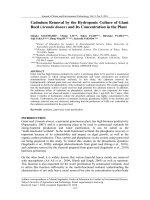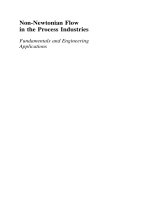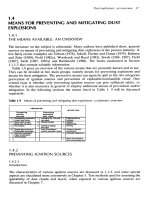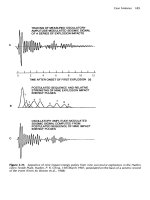material and energy balancing in the process industries 044482409x
Bạn đang xem bản rút gọn của tài liệu. Xem và tải ngay bản đầy đủ của tài liệu tại đây (25.5 MB, 649 trang )
MATERIAL AND ENERGY BALAN CIN G
IN THE PROCESS INDUSTRIES
From Microscopic Balances to Large Plants
COMPUTER-AIDED CHEMICAL ENGINEERING
Advisory Editor: L.M. Rose
Volume 1: Distillation Design in Practice (L.M. Rose)
Volume 2: The Art of Chemical Process Design (G.L. Wells and L.M. Rose)
Volume 3: Computer-Programming Examples for Chemical Engineers (G. Ross)
Volume 4: Analysis and Synthesis of Chemical Process Systems (K. Hartmann and
K. Kaplick)
Volume 5: Studies in Computer-Aided Modelling, Design and Operation
Part A: Unit Operations (1. Pallai and Z. Fony6, Editors)
Part B: Systems (1. Pallai and G.E. Veress, Editors)
Volume 6: Neural Networks for Chemical Engineers (A.B. Bulsari, Editor)
Volume 7: Material and Energy Balancing in the Process Industries - From Microscopic
Balances to Large Plants (V.V. Veverka and F. Madron)
COMPUTER-AIDED CHEMICAL ENGINEERING, 7
MATERIAL AND ENERGY
BALANCING IN THE
PR O CES S IND U STRIES
From Microscopic Balances to Large Plants
Vladimir V.
Veverka
Franti~ek Madron
ChemPlant Technology,
Ostf nad Labem, Czech Republic
1997
ELSEVIER
Amsterdam Lausanne New York Oxford Shannon Tokyo
ELSEVIER SCIENCE B.V.
Sara Burgerhartstraat 25
P.O. Box 211, 1000 AE Amsterdam, The Netherlands
ISBN: 0-444-82409-x
9 1997 Elsevier Science B.V. All rights reserved.
No part of this publication may be reproduced, stored in a retrieval system or transmitted in
any form or by any means, electronic, mechanical, photocopying, recording or otherwise, wit-
hout the prior written permission of the publisher, Elsevier Science B.V., Copyright &
Permissions Department, P.O. Box 521, 1000 AM Amsterdam, The Netherlands.
Special regulations for readers in the USA - This publication has been registered with the
Copyright Clearance Center Inc. (CCC), 222 Rosewood Drive, Danvers, MA 01923.
Information can be obtained from the CCC about conditions under which photocopies of parts
of this publication may be made in the USA. All other copyright questions, including photo-
copying outside of the USA, should be referred to the copyright owner, Elsevier Science B.V.,
unless otherwise specified.
No responsibility is assumed by the publisher for any injury and/or damage to persons or
property as a matter of products liability, negligence or otherwise, or from any use or
operation of any methods, products, instructions or ideas contained in the material herein.
This book is printed on acid-free paper.
Printed in The Netherlands
Contents
Chapter 1
Chapter 2
Chapter 3
Chapter 4
Introduction
Balancing in Process Industries
2.1
2.2
2.3
2.4
2.5
2.6
2.7
The Problem Statement ,
Balancing Flowsheet- Graph Representation
Balancing Variables and Data Preprocessing
Data Reconciliation
Classification of Variables
Data Collection and Processing
Recommended Literature
Mass
3.1
3.2
3.3
3.4
3.5
3.6
3.7
(Single-Component) Bal~ce
Steady-State Mass Balance
and its Graph Representation .
More on Solvability
3.2.1 Partition of variables and equations
3.2.2 Transformations
Observability and Redundancy
3 3.1 Definitions and criteria
3.3.2 Classification methods
and transformation of equations
Illustrative Example
Just Determined Systems
Main Results of Chapter 3
Recommended Literature
Multicomponent Balancing
4.1
4.2
4.3
4.4
4.5
4.6
4.7
4.8
4.9
Chemical Reactions and Stoichiometry
Component Mass Balances
Reaction Invariant Balances
Element Balances
Reaction Invariant Balances in a System of Units .
Example of Multicomponent Balance
Unsteady-State Balances
Main Results of Chapter 4
Recommended Literature
7
7
12
15
19
20
22
24
25
25
31
31
34
37
37
39
42
49
55
58
59
59
63
70
77
79
83
87
91
96
vi Material and Energy Balancing in the Process Industries
Chapter 5
Energy Balance
5.1
5.2
5.3
5.4
5.5
5.6
5.7
5.8
Enthalpy Balance
Graph and Matrix Representation
of the Enthalpy Balance
Example of Enthalpy Balance
Heat and Mass Balancing
Remarks on Solvability
Unsteady Energy Balance
Main Results of Chapter 5
Recommended Literature
99
99
108
111
118
123
124
127
132
Chapter 6
Entropy and Exergy Balances
6.1 Exergy and Loss of Exergy
6.2 Simple Examples
6.3 Examples of Exergetic Analysis
6.3.1 Heat exchanger network
6.3.2 Distillation unit
6.3.3 Heating furnace
6.4 Concluding Remarks
6.5 Recommended Literature
135
135
137
170
170
172
173
175
176
Chapter 7
Solvability and Classification of Variables I
Linear Systems
7.1 General Analysis
7.2 Canonical Format of the System of Equations
7.3 Commentary and Examples
7.4 Main Results of Chapter 7
7.5 Recommended Literature
177
177
184
191
196
199
Chapter 8
Solvability and Classification of Variables II
Nonlinear Systems
8.1 Simple Examples
8.2 Solvability of Multicomponent Balance Equations
8.3
8.2.1 Transformation of the equations
8.2.2 Additional hypotheses
8.2.3 Independent variables
8.2.4 Degrees of freedom
8.2.5 Solution manifold
8.2.6 Remarks
8.2.7 Example
General Solution Manifold
8.3.1 Energy balance equations
201
201
213
213
217
224
228
234
235
238
244
244
vii
8.4
8.5
8.6
8.7
8.3.2 The whole system of balance equations
8.3.3 Heat exchangers
8.3.4 Heat and mass balances
8.3.5 General nonlinear models
Jacobi Matrix and Linearisation
Classification Problems;
Observability and Redundancy
8.5.1 Examples
8.5.2 Theoretical analysis
8.5.3 Theoretical classification
8.5.4 Classification in practice
Main Results of Chapter 8
Recommended Literature
250
251
255
257
258
265
265
270
277
284
288
295
Chapter 9
Balancing Based on Measured Data- Reconciliation I
Linear Reconciliation
9.1
9.2
9.3
9.4
9.5
9.6
9.7
Problem Statement
Reconciliation Formulae
Statistical Characteristics of the Solutions;
Propagation of Errors
Gross Errors
Systematic Errors
Main Results of Chapter 9
Recommended Literature
297
297
303
312
329
342
345
350
Chapter 10
Balancing Based on Measured Data- Reconciliation II
Nonlinear Reconciliation
10.1 Simple Examples and Problem Statement
10.2 Conditions of Minimum
10.3 Properties of the Solution
10.4 Methods of Solution
10.4.1 Improving the initial guess
10.4.2 Suboptimal reconciliation
10.4.3 Final reconciliation
10.4.4 Short-cut method
10.4.5 Remarks ,
10.5 Gross Errors
10.6 Example
10.7 Main Results of Chapter 10
10.8 Recommended Literature
353
353
364
367
374
374
376
380
384
387
394
399
409
414
Chapter 11
Dynamic Balancing
11.1 Mass Balance Model with Accumulation
417
417
viii Material and Energy Balancing in the Process Industries
11.2
11.3
11.4
Daily Balancing
Conclusion
Recommended Literature
422
434
435
Chapter 12
Measurement Planning and Optimisation
12.1 Single-Component Balancing
12.1.1 Finding the first solution
12.1.2 Optimal measurement placement from
the standpoint of measurement precision .
12.2 The General Case
12.2.1 Problem statement
12.2.2 Objective functions
12.2.3 Theory
12.2.4 Solution of the problem
12.2.5 Results
12.2.6 Example
12.2.7 Optimality of the solution
12.3 Main Results of Chapter 12
12.4 Recommended Literature
437
437
438
440
441
441
442
443
444
447
449
452
453
454
Chapter 13
Mass and Utilities Balancing with Reconciliation in Large Systems
A Case Study 457
13.1 The Problem Statement 457
13.2 Requirements on the Industrial Balancing System . 460
13.3 Important Attributes of an Industrial Balancing System463
13.4 Balancing Errors 465
13.4.1 Mistakes in the balance flowsheet
- topology errors 465
13.4.2 Analysis of balance inconsistency
- balance differences 467
13.4.3 Identification of the cause of a gross error 468
13.5 Structure of the Balancing System IBS 469
13.6 Configuration of the Balancing System
- A Case Study 472
13.7 Examples of Balancing Proper 475
13.7.1 Correct balance
-
the base case 475
13.7.2 Balancing with a gross error 477
13.7.3. Some quantities unobservable 478
13.7.4 Topology error- some streams missing 479
13.7.5 Topology errors - too many fixed streams 480
13.7.6 Reporting 481
ix
13.8
13.9
Experience with Company-Wide Mass and Utilities
Balancing
13.8.1 Balancing in operating plants
13.8.2 Implementation of a company-wide
balancing system
Conclusions
481
482
482
485
Appendix A Graph Theory
A.1 Basic Concepts
A.2 Subgraphs and Connectedness, Circuits and Trees
A.2.1 Subgraphs and connected components
A.2.2 Connected graphs, circuits, trees
A.3 Properties of the Incidence Matrix
A.3.1 Case when G is a tree
A.3.2 General connected graph, elimination
of circuits
A.4 Graph Operations ,
A.4.1 Finding connected components
A.4.2 Derived operations
A.4.3 Merging of nodes
A.5 Costed Graphs
A.6 Recommended Literature
487
487
491
491
493
497
498
500
503
503
506
506
507
513
Appendix B
Vectors and Matrices
B.1
B.2
B.3
B.4
B.5
B.6
B.7
B.8
B.9
B.10
B.11
Vector Spaces
Dimension and Bases
Vector Subspaces
Classical Vector Spaces
Linear Maps
Matrices
More on Matrices; Elimination
Matrix Operations
Symmetric Matrices
Orthogonality
Determinants
515
515
518
521
523
526
532
538
543
551
554
562
Appendix C Differential Balances
C.1
C.2
C.3
C.4
C.5
C.6
Material Continuum
Interface Balances
Thermodynamic Consistency
Exact Integral Balances
Electrochemical Processes
Recommended Literature
571
571
575
576
578
582
584
X Material and Energy Balancing in the Process Industries
Appendix D Differential form of the 2nd Law of Thermodynamics . .
D.1 Recommended Literature
585
588
Appendix E
Probability and Statistics
E.1 Random Variables and their Characteristics
E.2 Special Probability Densities
589
589
597
Appendix F Exercises
609
List of Symbols
623
Subject Index
633
Chapter 1
INTRODUCTION
Material and energy balancing belongs to very frequent chemical
engineering activities. In spite of this fact, a systematic treatment of this topic in
the form of a monograph is quite rare. Balancing also usually forms one or more
introductory chapters in general chemical engineering textbooks, but the limited
space available there usually makes not possible to cover this subject in depth.
The classical treatment of balances in the literature available (which was
excellent at the time of publishing) needs to be complemented nowadays for
several reasons.
Balancing belonged to the first successful use of computers in chemical
engineering in early sixties. Since then the spread of computers (and especially
personal computers) influenced balancing significantly. The classical steady state
balancing in the stage of process design now represents only a part of balancing
problems we can meet in practice.
Mass and energy balancing (accounting) now becomes to be a standard
feature of
plant information systems
as a part of efforts to guarantee
good house-
keeping
of operating plants. Process plants very often represent complex systems
linked to one another to enable functioning in the most efficient way. The
automatic computerised analysis and synthesis of balancing relations
among hundreds or thousands of process streams requires a systematic
approach respecting all possible situations which can occur in practice. This fact
brought the need for new balancing techniques based on
graph theory
and
statistics.
The other important feature of balancing calculations is the danger of
insufficient accuracy of results.
Unmeasured flows and concentrations calculated
on the basis of imprecise data are in most cases differences of big numbers. This
fact influences adversely the accuracy of results and in some situation makes
them useless. The
confidence intervals
should be an integral part of balancing
results based on imprecise data. Even more dangerous is the possible occurrence
of
gross measurement errors
which can devalue results even more seriously. The
problems of confidence intervals and gross errors detection and elimination can
be solved by data
reconciliation.
Instrumentation in process plants is very often not sufficient for setting
up detailed and reliable balances. Design and maintenance of instrumentation
systems is strongly influenced by control engineers with the primary target of
process control. To improve situation in this area new techniques of
instrumenta-
2 Material and Energy Balancing in the Process Industries
tion design and optimisation
for balancing purposes are now available (optimum
measuring placement).
Retrofitting and revamping of operating plants is now important part of
investment to process industries. The new design of the plant relies heavily on
underlying process data. Material and energy balances needed for retrofitting and
revamps must be much more detailed than is common in regular plant operation.
Special
plant tests
are run with additional (portable) instrumentation. The
reliability and completeness of balances influences the success of overall project
significantly.
Increased interest in energy conservation in large systems requires a
systematic approach to consistent problem definition. Particularly successful is
the use of pinch technology. The application of pinch technology to existing
plants (revamps) depends on reliable heat and energy balances. The Classical
energy (or enthalpy) balances are now complemented by balancing of entropy
and exergy (availability).
There are also new balancing techniques used in the process control
(dynamic balances, instrumentation design and maintenance, etc.). Advanced
control techniques incorporated in process computers are very often based not
only on directly measured variables but also on secondary variables calculated
from balance models.
The present book will complement the information present in classical
balancing literature by the following topics:
systematic analysis of large systems by Graph theory
comprehensive thermodynamic analysis (entropy and availability)
balancing on the basis of redundant raw plant data (reconciliation,
propagation of random measurement errors, detection and elimination of
gross errors)
measurement design and optimisation (optimal measurement placement)
dynamic balancing
experience with plant-wide regular mass and energy balancing as a part
of plant's process information system.
The structure of the book is as follows:
The most elementary and unequivocal balance of a technological system
is its
mass balance,
dealt with in Chapter 3. Although the balance of a node (unit
of the system) is almost trivial (mass in = mass out + possible accumulation), the
fact that the individual nodes are connected by streams where output stream from
one unit becomes input stream into another unit gives rise to a complex structure
represented by the
graph of the system.
The methods of Graph theory enable one
to analyse completely the problems of solvability in a mathematically precise
Chapter 1-
Introduction 3
manner. They are treated rather extensively with the aim to give the reader an
idea of the basic concepts used henceforth: the graph representation, the partition
of the streams into
measured
and
unmeasured, solvability conditions, observabili-
ty and
redundancy.
Generally, the streams are mixtures of several chemical species
(components of the mixture). The
multicomponent balancing
is dealt with in
Chapter 4. Certain nodes of the system can be
reaction nodes.
Having specified
the chemical reactions considered admissible in a reaction node, by the laws of
chemical stoichiometry the balance of a reacting species involves a source term
due to the (positive or negative) production of the species by the reactions. Using
an algebraic procedure described in Section 4.3, the (usually a priori unknown)
source terms can be eliminated giving a set of'reaction invariant balances'; so
the number of unknown variables (parameters) is reduced. Of main interest are
steady-state balances neglecting the terms due to accumulation in the nodes. The
formulation of an unsteady-state balance brings no theoretical problem (see
Section 4.7); specified is the balance of a batch reactor.
The exact
energy balance
(Chapter 5) is only hypothetical. In practice,
less relevant items (such as kinetic and potential energy) are neglected and
neglecting also the accumulation terms, we have the steady-state
enthalpy
balance.
Each material stream is assigned its specific enthalpy with the condition
that the specific enthalpies are thermodynamically consistent. In addition we
introduce net
energy streams
representing heat transfer or also mechanical power
supply completing the balance of any node. For the case that only total mass is
balanced along with energy (enthalpy), a simplified version of the balance is
presented in Section 5.4 (heat and mass balancing); an important special case is
a heat exchanger network. For completeness, in Section 5.6 we give general form
and examples of unsteady energy balance.
Of different nature is the entropy balance dealt with in Chapter 6. It is
not a balance in the proper sense because no quantity is conserved. In fact it is
a method of
thermodynamic analysis
of the processes in the system. More
familiar to engineers is the notion of
exergy (availability).
The (necessarily
positive) production of entropy in any node is proportional to the
loss of exergy
in the node; the goal is to reduce the loss as far as possible. The chapter gives
a number of examples of such thermodynamic analysis, along with critical
comments.
Chapters 7 and 8 are devoted to the
problems of solvability.
We call a
set of equations
solvable
when there
exists
some vector of solutions, not
necessarily unique. In Chapter 3, we have shown that the set of mass balance
equations is always solvable if no variable has been fixed a priori. With
redundant measured variables, the equations need not be (and usually are not)
solvable, unless the fixed variables have been adjusted. Then certain unknown
(unmeasured) variables are uniquely determined (observable), other still not
(unobservable variables). Certain measured variables can be nonredundant: they
4 Material and Energy Balancing in the Process Industries
are not affected by the solvability conditions thus their values are arbitrary. The
set of mass balance equations is an example of a linear system. In Chapter 7 we
analyse the solvability of a linear system in general, using the methods of linear
algebra. In particular we transform the equations to (what we call the) canonical
format (Section 7.2) and give explicit criteria for the solvability classification.
The main goal is to give methods that can be applied to the (considerably more
difficult) analysis of non-linear systems.
The multicomponent chemical species and energy balances are mostly
non-linear in the primary variables (mass flowrates, mass fractions, temperatures,
possibly also pressures of the streams). The solvability analysis of non-linear
systems in Chapter 8 begins with examples showing that even in simple cases,
the terminology introduced for linear systems (in particular observability and
redundancy) becomes somewhat vague: certain problems can be 'not well-posed'.
We then first analyse the solvability of the whole system of balance equations
without a priori fixed variables (Sections 8.2 and 8.3) and show that under
certain plausible structural hypotheses, the system is solvable.
If the values of certain variables have been fixed a priori (for example
measured), there is no mathematically precise general solution to the observabi-
lity and redundancy classification problem. We did not attempt to arrive at a
complete analysis. Still, we have shown that remitting somewhat the mathemati-
cal precision, a pragmatically plausible classification is possible if the problem
is linearized.
In Chapters 9 and 10, we deal with balancing based on measured data.
The measured data are subject to random errors, and are processed by statistical
methods. A statistically rigorous approach is possible if the balance constraints
are linear; see Chapter 9. The measured data are first adjusted so as to obey the
solvability conditions and minimise the generalised sum of squares of the
adjustments; the procedure is called reconciliation. In particular if the distribution
of measurement errors is Gaussian with zero mean, we thus obtain the maximum
likelihood estimates. Also the estimates of the unmeasured observable variables
can then be computed. Even if the distribution is not Gaussian, we can compute
statistical characteristics (in particular standard deviations) of the estimates (and
possibly also of other variables dependent linearly on the former). With a
Gaussian distribution, the confidence intervals for the estimates are thus found.
Important is the fact that the presence of redundant measured variables generally
improves the precision of the results. On the other hand a measurement error in
one variable affects also the estimates of other variables (so-called propagation
of errors); in particular the presence of gross errors can spoil the whole result
of reconciliation. Methods of detection and elimination of gross errors can be
based on the statistical analysis of data; see Section 9.4.
A rigorous formulation of the reconciliation problem is possible even
with non-linear constraints; only the general existence and uniqueness of a
Chapter 1 -
Introduction 5
solution is not warranted theoretically. Still, with possible exception of
considerable gross errors or inadequate selection of the measured variables the
problem appears as solvable in practice as shown in Chapter 10. The methods are
based on successive approximations (such as successive quadratic programming),
where the special character of the criterion to be minimised can be made use of;
see Section 10.4. Although not rigorous from the statistical point of view, the
approximate statistical characteristics of the estimates can be computed if the
constraints are linearised at the final solution. The latter linearisation makes also
possible to classify the variables according to Subsection 8.5.4 of Chapter 8.
Finally the methods of detection and elimination of gross errors according to
Chapter 9 can be applied to the linearised system of equations (Section 10.5).
Chapter 11 deals with
dynamic
(unsteady-state) mass
balancing
of a
technological system involving inventories. A straightforward method of
reconciliation is presented avoiding accumulation of small systematic errors in
the time series of measurements. The method has proved successful in practice
and can also be supported by theoretical arguments.
There is generally a great number of possibilities how to
select
the set
of values to be measured, thus the
measuring points.
The criteria of optimality
and the ways leading towards an optimum are analysed in Chapter 12. A more
or less heuristic procedure is suggested eliminating successively measuring points
that involve high costs and/or give unprecise estimates of the required quantities.
If theories and methods presented in the book should to be successful in
the practice, many prerequisites must be fulfilled. Typical example of the
complexness of the problem can be regular (e.g. daily) balancing in process
plants based on measured data. Chapter 13 deals with problems which can be
encountered in regular balancing of mass and utilities in refinery and petrochemi-
cal complexex. The analysis of the problem is complemented by the experience
gained during development and implementation of mass and utilities balancing
with reconciliation in the framework of company's process information system.
It is the intention of authors to present balancing techniques in a
systematic and rigorous way. To make the book at the same time more readable,
some parts are included in 5 Appendices. The appendices A,B, and E will enable
the reader to brush up and possibly extend his knowledge of graph theory, vector
and matrix algebra, and statistical theory pertaining to the problems of balancing.
For the interested reader's convenience, the theory is presented in a largely self-
contained manner, with (at least outlined) mathematical proofs. In perusing
Chapters 3-8, the reader can manage with Appendix A and Sections B.1-8 of
Appendix B. Sections B.9-11 and Appendix E constitute the theoretical basis of
Chapters 9-11.
The subtitle of the book reads 'From microscopic balances to large
plants'. The first part of the promise is fulfilled in Appendices C and D. If the
reader is more deeply interested in the physics underlying the ('macroscopic')
node balances, before perusing Chapters 4 and 5 he can begin with Appendix C,
6
Material and Energy Balancing in the Process Industries
and with Appendix D before Chapter 6. He will then perhaps better understand
the complex nature of the processes in the technological units, and the (neces-
sary) simplifications adopted in setting-up the balances of a technological system.
There are many examples throughout the book which serves for better
understanding of theory presented there. To gain more practice in solving
balancing problems, Appendix F presents several exercises dealing mostly with
balancing with reconciliation. The exercises are used in reconciliation courses
given by one of the authors of the book. Unfortunately, the data reconciliation
is out of reach of the power of pocket calculators even for very simple
flowsheets. If the reader wants to go through the workshop based on Appendix
F, he can obtain (free of charge) mass and heat balancing software RECON
suitable for IBM compatible personal computers (see the coupon at the end of
the book). This software is sufficient for the complete solution of exercises
including the statistical analysis of data.
Chapter 2
BALANCING IN PROCESS INDUSTRIES
2.1 THE PROBLEM STATEMENT
Let's start with several simple examples illustrating basic balancing tasks
encountered in different branches of process industries (refineries, petrochemical
plants, inorganics, etc.).
Fig. 2-1. depicts a simple scheme for a mass balance. Besides the
distillation column (1) and a distillate storage tank (2), the scheme comprises also
more complex subsystems of apparatuses which are balanced here as "black
boxes". Node (5) represents here a distributor of electric energy supply.
2 3
12
I
3
"-O
I
I
'I
Fig. 2-1. A flowsheet for a single-component balance
Streams are usually classified as process streams (streams 1 to 8) and
utilities, such as electricity or cooling water (streams 9 to 11). This classification
is useful, because process streams usually don't mix with utilities. Systems of
balancing equations of process streams and of individual utilities are often
independent and can be solved separately. The classification of the stream (12)
8 Material and Energy Balancing in the Process Industries
is problematic. In the subsystem (4) arises the process off-gas which is further
led to the subsystem (3) to be burned in a furnace; so it becomes here a utility
stream.
The most simple balance of the system in a certain (usually integral) time
interval means the complete information about
exchange of balanced quantities (overall mass, components, different
forms of energy, etc.) among separate elements (nodes) of the system or
among nodes and the environment
inventories of balanced quantities in nodes at the beginning and at the
end of the balancing interval, or how the inventories have changed
(accumulation)
At this moment we are interested in the overall mass flows in the case
of mass streams (for example in tons) and electric energy (for example in GWh).
We are not interested in other characteristics of streams as chemical composition,
because it can be supposed that the quality of the individual streams is
guaranteed by the control system.
Balance equations for this problem can be expressed as
sum of inputs = sum of outputs + increase of inventory
for every node in the system. It is the case of so-called
single component balance
when there is one balancing equation around any node. The balance can be also
classified as
dynamic
because the process need not be at steady state as we admit
the change of inventory in the tank (2). The incentive for setting up the balance
in such system is regular monitoring of yields of main products and of specific
consumption of utilities as a part of "good house keeping" of the plant.
Let's consider the second flowsheet in Fig. 2-2. where is the
distillation/absorption train for processing of refinery off-gases. Refinery off-gas
(1) consists of light hydrocarbons (C1 to C7), hydrogen and inert gases (N2, Ar).
The column No. 1 serves as absorber/desorber. Hydrogen, inerts and C1 and C2
hydrocarbons are boiled up in the bottom part of the column and heavier
hydrocarbons (C3, C4) are absorbed in the upper part of the column by heavy
hydrocarbons (C6 and C7). The lean gas (2) leaving the head of the column is
later burned in the furnace. The second column serves for separation of C3 and
C4 hydrocarbons from the absorbent (6) which circulates among columns (1) and
(2). The middle hydrocarbons (4) consisting mostly of propane and butanes are
separated in the third column which produces commercial products propane (7)
and butane (8).
Chapter 2 - Balancing in process industries 9
2 t 7
Fig. 2-2. Separation of light hydrocarbons
2
v
3
I
In this case we are interested in so-called multicomponent balance when
individual components (inerts, individual hydrocarbons and hydrogen) are
conserved. We can write one component balance equation for every component
and the column (if the component is present in this column). The result of the
balance is the complete information not only about overall flows but also about
the composition of individual streams.
Such multicomponent balance is important for tracing valuable
components in the process. The value of commercial products (propane and
butane) is much higher than the value of the lean gas. Significant economical
losses can occur if the absorption in the first column does not operate properly
and valuable hydrocarbons are lost in the lean gas.
There are also other incentives for setting up such multicomponent
balance. The balance in a multicomponent system can serve for validation of
sampling and analytical methods. The analysis of imbalances (inputs minus
outputs) can reveal errors caused by improper sampling or erroneous analytical
methods.
Nowadays, process simulators which can simulate the behaviour of the
plant on the computer are more and more used for the optimisation and control
of processes. The major problem in using simulators is their tuning to simulate
properly all important features of the real process. This can be done only by
comparison of the result of simulation with the complete component balance set
up on the basis of plant data.
input output
reactor
C12, CH4 CI_,, CH4, CH3C1, CH2C12,
CHCls, CC14, HC1
Fig. 2-3. A chlorination reactor
10 Material and Energy Balancing in the Process Industries
There is a chlorination reactor in Fig. 2-3. Methane is chlorinated in a complex
reaction set which can be summarised as
CH 4 + C12 = CH3C1 + HC1
CH3C1 +
C12 = CH2C12 + HC1
CH2C12 + C12
= CHC13 +
HC1
CHC13 + C12 = CC14 + HC1.
In this case the individual components are not conserved in the reactor
as they can be consumed or created by reactions. The balance of the reactor is
governed by the stoichiometry of the reaction system. In this case we speak about
the
multicomponent balance with chemical reaction.
The result of balancing is
the complete information about amount of individual components entering and
leaving the reactor and also about reaction characteristics as
reaction rates
or
extents of reaction.
Balancing of reacting systems is important for detailed
analysis of processes running in the reactor, either in the stage of laboratory or
pilot plant studies, or as regular monitoring of industrial reactors behaviour
(yields, selectivity). In the last case it is possible to reveal important changes as
improper control, ageing of the catalyst, etc., which can cause serious economic
losses or even jeopardise the safety of the whole process.
Another flowsheet is in Fig. 2-4. The distillation column is
complemented by two heat exchangers which makes possible preheating of the
feed by the contact with hot bottom product. In practice, especially in refinery
and petrochemical industries, we can meet even with much complicated heat
exchange systems consisting of dozens of heat exchangers which make processes
economically viable.
feed
I
9 ~ distillate
bottom product
Fig. 2-4. A feed of the column preheat
To analyse such system the heat or enthalpy balance must be set up,
which includes the complete information about enthalpy of streams and also
Chapter
2 - Balancing in process industries 11
about heat fluxes occurring among some parts of the system. We can meet with
this kind of balancing either when designing a new process, or during
monitoring or control of the existing process (evaluation of heat transfer
coefficients, calculation of unmeasured temperatures, etc.). Such monitoring can
reveal, for example a common quiet "thief' in process plants - a heat exchange
area fouling.
All these examples given above represent a broad class of needs we can
meet in practice. The information about balanced quantities are obtained by
solving the system of balance equations on the basis of measured or otherwise
specified values of variables. There are two basic types of balance calculations.
For the first case is typical that some variables (flows, inventories, etc.)
are fixed and the other are calculated by direct solving the system of equations.
The number of unknowns equals the number of independent equations and the
selection of unknowns must guarantee the solvability of the system. This
situation is typical for example for steady-state balancing in the stage of the
design of the process. This type of balancing which can be reduced to equations
solving was the main topic in earlier chemical engineering balancing literature.
The solution is relatively easy (with the use of computers and balancing software
which is now available). The one problem can be the selection of the set of
independent variables which makes the problem just solvable. Such a system of
independent variables can differ from the set we would like to specify
independently. The other problem can be the consistent set of enthalpy data in
the case of energy balancing. Nowadays process simulators are widely used for
designing of new processes which are capable of setting up the complete material
and energy balance of even very complicated processes.
The other area of mass and energy balancing concerns the analysis of
operating processes. The advent of process computers brought the huge amount
of process data from operating plants, sometimes of dubious quality. At the same
time the widely spread personal computers brought an immense computing power
to process engineers.
The situation here is much more complicated than in the case of
balancing in the design area. The occurrence of measured variables in operating
processes depends mostly on the instrumentation which is usually dictated by
control engineers to guarantee good controllability of the process. Less attention
is given to balancing needs, where very often only basic inputs and outputs are
measured with sufficient precision (the custody measurement). On the other hand,
in some areas where the control is critical there is more information for balancing
than needed, we say that the instrumentation is redundant. So we can meet very
often with insufficient instrumentation in one part of the plant and with huge
amount of redundant data in the rest. All this influences the unique solvability
of the system of balancing equations and makes the balancing more difficult.
This situation which started in early sixties brought the need for
systematic methods for the second type of balancing- the balancing based on
12
Material and Energy Balancing in the Process Industries
measured data. Besides problems with redundant or insufficient data also other
problems have to be solved. Statistical methods were used for the adjustment of
controversial data by reconciliation. Reconciliation which was developed about
two hundred years ago was re-invented for balancing in early sixties. Since then
many problems typical for the use of reconciliation in process engineering were
successfully solved.
Results of balancing based on measured data are significantly influenced
by measurement errors. The propagation of measurement errors in the process of
balancing provides the information about the reliability of results by confidence
intervals. Very useful are techniques of the statistical analysis of process data
aimed at detection and elimination of gross measurement and other gross errors.
It is also possible to optimise the instrumentation to improve results of balancing.
All this theory and techniques are now available to improve the quality of mass
and energy balancing in process plants.
2.2 BALANCING FLOWSHEET - GRAPH REPRESENTATION
In the plant documentation we can usually meet with process and
instrumentation (P&I) diagrams which contain the process equipment and the
instrumentation and control loops. P&I diagrams are usually too much detailed
for balancing purposes. We can simplify them by deleting control loops and a
part of instrumentation which is not needed for balancing purposes. Very often
the flowsheet can be further simplified by ignoring of some parts of equipment
or by merging some pieces into one equipment.
For example, in the case of mass balance, pumps can be neglected
because they have only one input and one output and their mass balance is a
trivial one. Even in the case of enthalpy balance, pumps are often neglected as
the shaft work exerted on the pump is often negligible in comparison with the
enthalpy changes of streams. Similarly, if only the multicomponent balance is set
up around a distillation column, the column proper is usually merged with the
condenser, boiler, or other supporting equipment.
The resulting flowsheet whose complexness is just sufficient for the
purpose of the balance is finally redrawn in the graph form. The graph
representation of the flowsheet for the single-component balance shown in
Fig. 2-1 is in Fig. 2-5. The graph consists of
nodes
(circles) and
streams
(arrows). Every stream is incident either with two nodes or with one node and
the environment (which can be viewed also as one of the nodes).
Chapter 2 -
Balancing in process industries
13
T
13
,~~ 3
8
w
Fig. 2-5. A graph representation of balancing flowsheet
By comparing Figs. 2-1 and 2-5, we can see that the new stream (13)
occurred in Fig. 2-5. This stream represents the artificial (fictitious) stream - the
accumulation of mass in the tank (2). We will meet with artificial streams more
in the next parts of the book.
The direct application of conservation laws to the graph in Fig. 2-5 in the
present form would lead to some problems. For example, there are different kinds
of streams incident with the node (3) - mass streams, electric energy streams and
the heating gas (12). As we try to set up the single-component balance (only one
balancing equation around every node), we must separate streams according to
the kind of the stream. The final graph representation of the balancing flowsheet
is in Fig. 2-6. The original graph breaks into two parts which have the only node
common - the environment (the environment node is not shown in the Fig. 2-6
explicitly). It is also worth mentioning the stream 12 which is used as the fuel
in the node 3. This stream can't be taken into account in the mass balance of the
node 3, so that the direction of this stream is from the node 4 to the environment.
14
Material and Energy Balancing in the Process Industries
13
2 3 ~.
4 ll 21 2
7 5 /'@,
Fig. 2-6. A balancing graph after decomposition
8
v
Nodes in balancing flowsheets can be classified in several groups. The
most common are
nonreaction nodes.
Typical representatives are distillation and
absorption columns, heat exchangers or pipe junctions. Pipes are usually
represented by arrows, but in some special situations pipes can be viewed as
nodes. Examples here are balancing heat losses from the pipe or dynamic
balancing flows of a compressible fluid in a distribution network. Special types
of nonreaction nodes are so-called
splitters
with two or more outgoing streams
of the same composition, temperature, etc. Some unit operations can be split in
two or more fictitious nodes. For example, heat exchangers are usually balanced
as tube and shell sides connected by a fictitious stream which represents the heat
flux in the exchanger.
Reactors
are nodes where chemical transformation occurs. To maintain
the conservation law, the fictitious streams representing sources or sinks of
reacting components going to or from the environment can be defined. It is also
possible to eliminate the fictitious streams by an algebraic procedure expounded
in Chapter 4.
Separate units (such as storage tanks) where the material is only stored
(and the inventory can be measured) can be called
inventory nodes.
They are
each connected by a fictitious stream (accumulation) with the environment.









